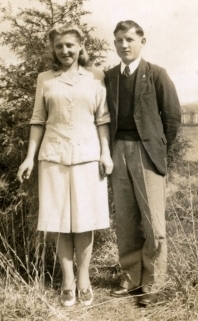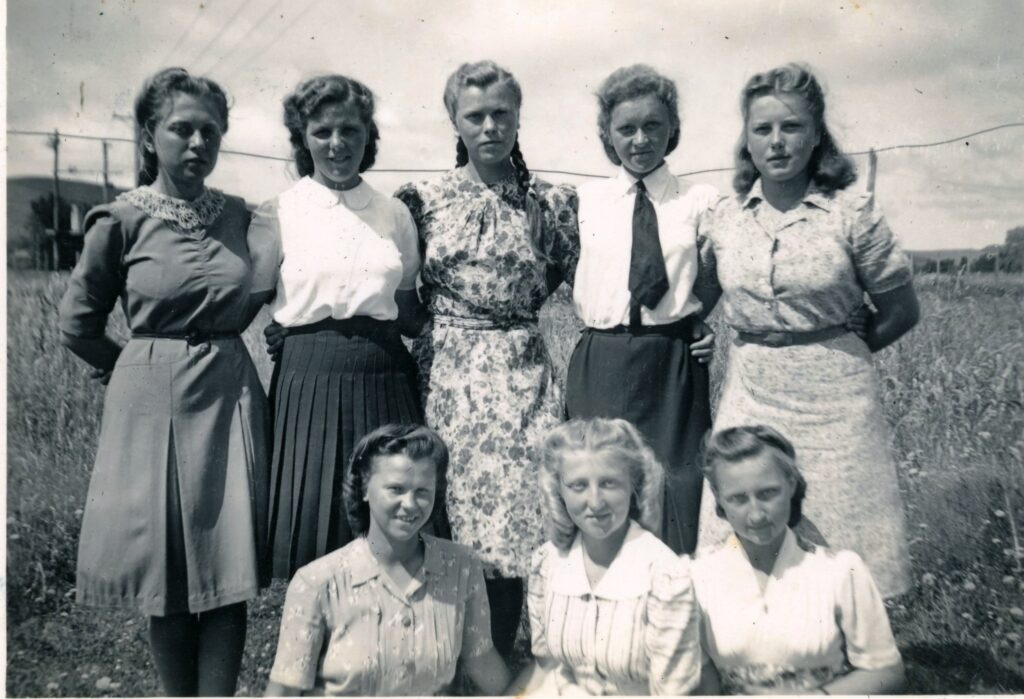Barbara Scrivens
Jadwiga née Jarka Cooper, one of our most colourful Auckland Polish community members, died peacefully on Wednesday, 12 June 2024, aged 96.
Pani Jadzia and her younger brother, Janek, were among the 733 Polish children who arrived in Wellington with their 105 caregivers on 31 October 1944, after the New Zealand government invited them to spend the balance of the war in a peaceful country. Their father, Stanisław Jarka, a detective in the Białystok Police Department before the war, was among the more than 22,000 Poles shot by Soviet Secret Police (NKVD) in western Russia in 1940 in what became known as the Katyń massacres.

Pani Jadzia was 12 in 1940 when Soviet soldiers barged into their home in Białystok and took her, her brother, and her stepmother to northern Kazakhstan where they were moved from one impoverished kolkhoz to another. Life for the trio revolved around finding something to eat and somewhere to shelter. At one stage, they shared a room and a section of corridor with another mother, a grandmother and two other children in a house in Pavlodar.
Pani Jadzia was then so desperate to save her critically ill brother that that she stole a watermelon – only to accidentally leave it on a table in a railway station when she had to run for a train. A Polish soldier gave her stepmother an apple he had been saving for his own missing family, a gesture Pani Jadzia believed kept Janek alive. Her stepmother cut out the core, fed the flesh to Janek, who did not have the strength to sit up, and gave Pani Jadzia the core and stalk, which she ate “so slowly.”
An elderly Russian couple whom Pani Jadzia met soon after, saved the family by sharing their milk, cream, butter, and “other bits and pieces” but their generosity contrasted with “rascals” who took advantage of the local Russians and the abandoned Poles.
Pani Jadzia in a 2016 interview: “The owners [of the house] said that their family was coming, so we had to leave. We went to a stable. My brother and I had to sleep in a dog kennel. If you wanted to stretch, you had to open the door, but it was so cold, we shut the door.
“You were forever hungry. We slept in the same clothing as we worked. In summer at night-time, it was a ritual to go to the river. Stepmother would wash our clothes in the water, put them on the bushes. We hid, sat there, or played while we waited for them to dry. There was no cleanliness—just wet and dry. You take your garment, and you kill the lice in the seams.”
By signing the Polish-Soviet Agreement in London on 30 July 1941, at the height of Hitler’s Operation Barbarossa, Polish Prime Minister General Władysław Sikorski gave the Poles who were incarcerated in the USSR a means to leave: Stalin had agreed to a Polish army being formed on Russian soil.
Pani Jadzia’s stepmother had damaged her knee while labouring on lifting and de-icing railway tracks near the frozen Irtysh river, and had no means to travel with her stepchildren the considerable distance to any military or civilian camp established by the Polish army. With no money, no transport, and no food, the three would have remained in Kazakhstan had it not been for the American Red Cross setting up orphanages. Their stepmother placed Jadwiga and Jan in the care of one in Pavlodar.
The siblings moved from orphanage to orphanage, and ended up with about 300 others in Ashkhabad, now Ashgabat, Turkmenistan, near the border with then Prussia, now Iran.

Those 300 or so Polish children and their caregivers were among the last to leave the USSR. In groups, they crossed then Turkmen SSR’s precipitous southern border with Persia to reach first Mashhad, then Teheran. Shortly before Stalin broke off diplomatic relations with Poland a second time—over Poland’s public contention that the Soviets had murdered the Polish officers in the Katyń region of western Russia—the then Polish Ambassador to the USSR, Tadeusz Romer, apparently visited the Ashkhabad orphanage, and promised to get the children to Persia. An identity booklet issued to Jadwiga by the Polish delegation in Teheran shows that on 12 September 1943—a full year after Stalin closed the borders to Poles hoping to escape through Krasnovodsk (now Turkmenbashi) on the Caspian Sea—she was delivered to an orphanage in Isfahan.
Without this booklet, Jadwiga would not have known the route or the time it took for her and her brother to get from the Pavlodar orphanage in 1941 to their separate hostels in Isfahan in 1943. The booklet was more than that. It instructed the children on how they were expected to behave, the pocket money issued to them, what clothing they received while at the Isfahan orphanage, and what they were issued in New Zealand.
From the booklet: “Remember, you are an ambassador of your country. Therefore your behaviour and speech should be excellent, do not tarnish your name – through this, opinion of Poles and Poland will be degraded.
“You are being helped. Help others, be courteous, strive high…”
Pani Jadzia lived by those words. She was a foundation member of the Auckland Polish Association, and a stalwart of the Polish community in Auckland. She appears on several photographs in the Our History page of this website.

She was proud of her heritage and wanted her story to be heard. She made sure that each of her children, Christine, Mark, and Louise, had files of the information she gathered about her family in pre-war north-east Poland, her father’s work in the Białystok Police Force, her brother’s accomplishments, and the story of the children of the Polish Children’s Camp in Pahiatua. Pani Jadzia’s last visit to Dom Polski in Auckland, during our Pahiatua commemoration last year, was a happy one. She appeared in one of the posters, above, and was able to reminisce with her grandsons, Kian and Harrison Bright about her journey to New Zealand.
Spoczywaj w pokoju Pani Jadziu. Dziękuję za Twoją służbę.
Barbara Scrivens describes history of Poles in New Zealand and runs the internet site: https://polishhistorynewzealand.org
The article firstly published here: https://poloniaauckland.co.nz/jadwiga-nee-jarka-cooper-2/
Reprinted by permission of the Author. Photographs from the author’s collection.



